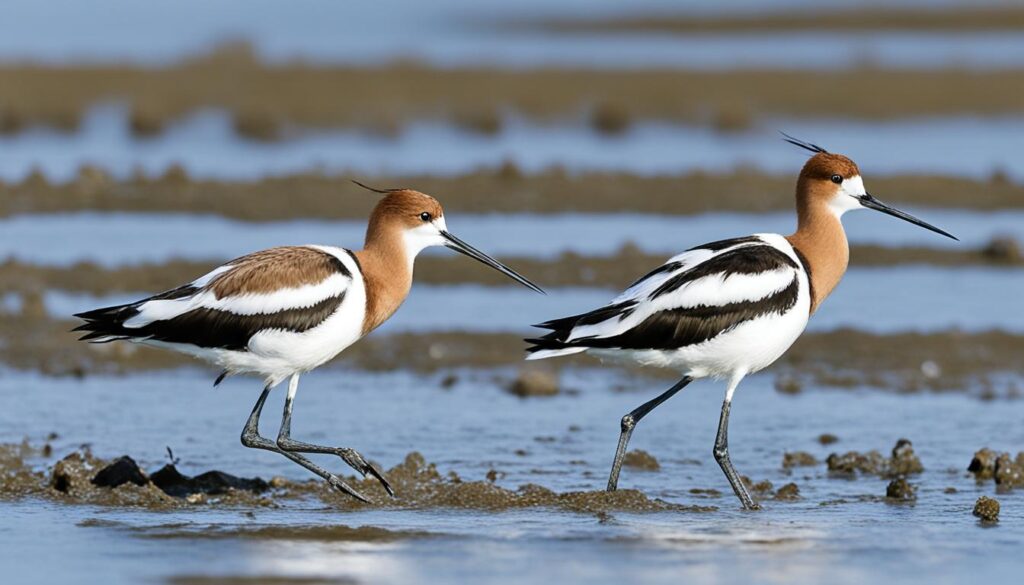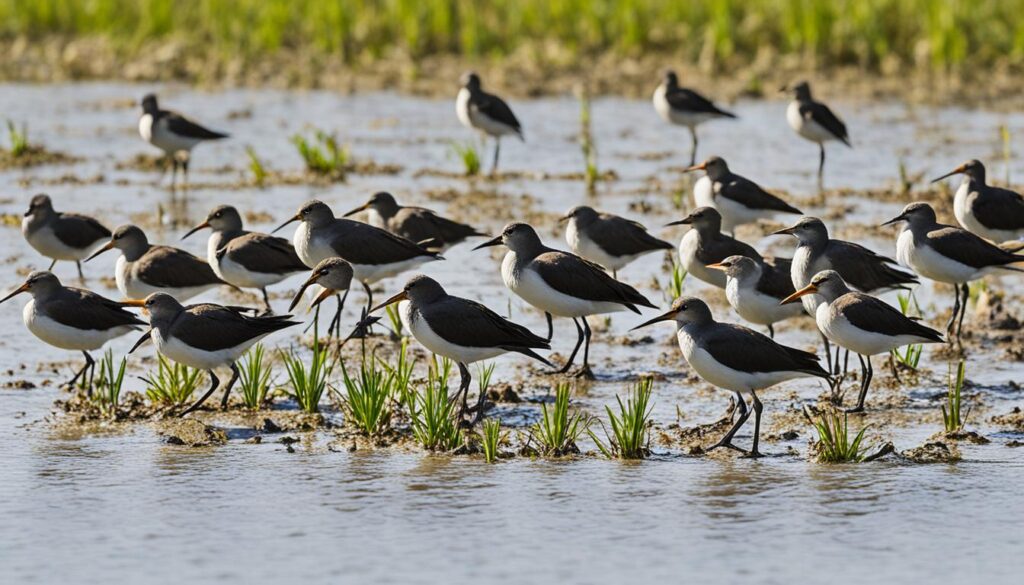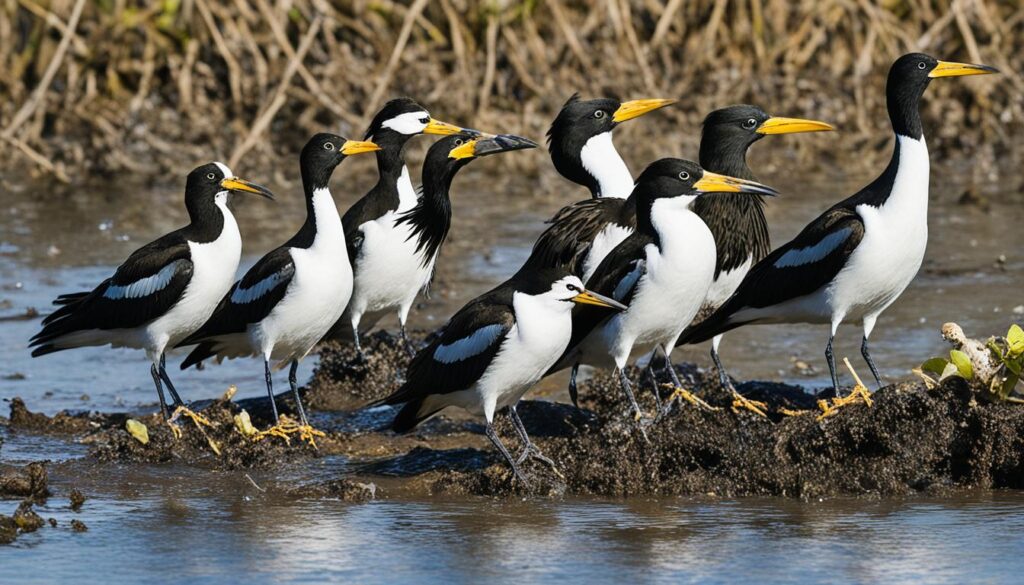Did you know that some birds are equipped with remarkably flat beaks, specially adapted for shoveling through mud to find their next meal? These unique avian foragers, including spoonbills, shovelers, avocets, and ibises, inhabit wetland habitats around the world, utilizing their wide, shovel-like bills to efficiently scoop up small fish, crustaceans, and aquatic insects from the mudflats and shallow waters they call home.
Key Takeaways
- Certain birds, such as spoonbills, shovelers, avocets, and ibises, have specialized flat beaks adapted for feeding in wetland habitats.
- These birds use their wide, shovel-like bills to scoop up small prey like fish, crustaceans, and aquatic insects from mudflats and shallow waters.
- Their unique beak shapes allow them to effectively sieve through the mud and capture their food sources in these productive but challenging environments.
- Flat-billed birds are well-suited for wetland habitats, including marshes, mudflats, and shallow waters, where they thrive as efficient mud-shoveling foragers.
- Understanding the specialized adaptations of flat-billed birds can provide insights into the diverse feeding strategies and ecological roles of these fascinating avian species.
Introduction to Flat-Billed Birds
The natural world is home to a remarkable diversity of bird species, each equipped with specialized adaptations to thrive in their respective habitats. Among this avian tapestry, a distinct group of flat-billed birds stands out for their unique feeding strategies in wetland environments. These flat-billed birds, including spoonbills, shovelers, avocets, and ibises, have evolved specialized beak shapes to effectively shovel, scythe, and probe through the mud in search of small invertebrates, fish, and other aquatic prey.
Overview of Birds with Specialized Beaks for Feeding
Birds have adapted a wide array of beak shapes and sizes to exploit diverse food sources and habitats. From the sharp, hooked beaks of raptors to the conical bills of seed-eating songbirds, each beak design reflects the unique feeding adaptations of a particular species. In the realm of flat-billed birds and wading birds, the specialized beak shapes allow them to thrive in shallow aquatic environments and mudflats, where they can efficiently shovel and probe for their prey.
These shorebirds and wading birds with flat beaks have developed a diverse array of feeding adaptations, from the broad, spoon-shaped bills of spoonbills to the upturned, scythe-like beaks of avocets. By exploring the feeding adaptations and beak shapes of these remarkable birds, we can gain a deeper appreciation for the intricate relationships between form and function in the natural world.
“The beak of a bird is like a multi-tool, adapted for the specific needs of each species. These flat-billed birds have honed their tools to thrive in the dynamic wetland environments they call home.”
Spoonbills: Nature’s Shovelers
Among the remarkable birds with flat, shovel-like beaks adapted for wetland feeding are the captivating spoonbills. These long-legged wading birds wield their distinctive spatula-shaped bills to sweep through shallow waters, scooping up a diverse array of prey including small fish, crustaceans, aquatic insects, and other aquatic invertebrates.
As spoonbills gracefully navigate the mudflats and wetland habitats, they employ a unique feeding technique that showcases the remarkable adaptations of their flat beaks. By moving their bills from side to side, they use the serrated edges and papillae (tiny sensory projections) to detect vibrations and capture their elusive prey.
“Spoonbills have evolved flat, spatula-shaped bills that enable them to scoop up water and separate mud and silt from food using complex structures called lamellae.”
This water shoveling behavior allows spoonbills to efficiently forage for a wide range of aquatic invertebrates that thrive in the nutrient-rich waters and mudflats of their wetland homes. Their specialized beaks are a testament to the remarkable evolutionary adaptations that have equipped these wetland birds with the tools they need to succeed as mudflat feeders.

Shovelers: Ducks with Flat Beaks
Among the diverse group of flat-billed birds, shoveler ducks stand out as masters of water shoveling. These unique waterfowl, such as the northern shoveler, have evolved specialized, wide, and spoon-shaped bills that allow them to efficiently forage in shallow, murky wetlands and mudflats.
Shoveler ducks use their distinctive flat beaks to scoop up small aquatic organisms, including insects, crustaceans, and tiny fish, from the surface of ponds, marshes, and mudflats. Their bills are equipped with hundreds of tiny comb-like structures called lamellae, which act as filters to separate food particles from the water. This adaptation enables shovelers to thrive in environments where other ducks may struggle to locate prey.
The northern shoveler, for example, has around 220 lamellae on its lower mandible and 180 on its upper mandible, making it a highly efficient water shoveler. In contrast, other duck species like mallards, pintails, and gadwalls have narrower bills due to their historical dietary differences, focusing more on grazing and foraging in specific habitats.
Shoveler ducks’ unique feeding behavior and adaptations make them well-suited for wetland environments, where they can exploit a range of aquatic food sources that are often overlooked by other waterfowl. Their flat beaks are a testament to the remarkable diversity of bird species that have evolved specialized features for thriving in diverse ecosystems.
“Shoveler ducks have evolved a remarkable adaptation that allows them to thrive in shallow, murky waters where other ducks struggle to find food.”
Avocets: Scything Through Mudflats
Among the shorebirds that thrive in the rich mudflat habitats are the avocets. These slender-bodied birds have evolved a truly unique feeding technique that allows them to excel in these dynamic environments. Avocets possess long, thin, upward-curving beaks that they use to “scythe” through the mud, sweeping their bills from side to side to locate and capture a variety of prey, including worms, crustaceans, aquatic insects, and other small aquatic invertebrates.
The avocet’s specialized bill is perfectly adapted for this foraging method. Its sensitive tip can detect the slightest movement and vibrations of hidden organisms beneath the surface, enabling the avocet to feed effectively in both clear and murky waters. As the avocet slowly sweeps its bill through the mudflats, it creates a distinctive swishing sound, almost like a scything motion, which is the source of its unique feeding technique.
The Unique Feeding Technique of Avocets
Avocets are true masters of the mudflat ecosystem. Their slender, upturned beaks allow them to effectively “scythe” through the mud, sweeping from side to side to locate and capture a diverse array of aquatic invertebrates. This specialized feeding method enables avocets to thrive in the rich, dynamic mudflat habitats that are home to a bounty of small prey.

“Avocets are a marvel to watch as they gracefully glide through the mud, their long, thin beaks cutting through the muck with precision and efficiency.”
The avocet’s unique feeding technique sets it apart from other shorebirds that frequent the mudflats. While some species may probe or peck at the surface, the avocet’s scything motion allows it to uncover prey that may be buried or hidden beneath the surface. This adaptability is a key factor in the avocet’s success as a mudflat feeder, allowing it to exploit a wide range of food sources in these productive wetland habitats.
Ibises: Mud-Probing Masters
Ibises, a group of distinctive wetland birds, are renowned for their exceptional mud-probing abilities. These wading birds have long, downcurved beaks that they use to plunge into the mud and extract a variety of prey, including crustaceans, mollusks, and even small amphibians from depths of up to 20 cm. The sensitive tips of their bills allow ibises to locate their prey by touch alone, making them well-suited for foraging in the murky, low-visibility conditions commonly found in wetland habitats.
Exploring the Downcurved Beaks of Ibises
The unique shape of an ibis’s beak is a prime example of evolution’s remarkable adaptations. The long, curved bill is ideally suited for the birds’ primary feeding strategy – probing deep into the mud to unearth hidden aquatic invertebrates and amphibians. This specialized beak structure enables ibises to access prey that other wetland birds may struggle to reach, giving them a distinct advantage in their wetland habitats.
Ibises’ feeding behavior is a captivating sight to observe. As these birds wade through shallow waters and mudflats, they use their sensitive bills to methodically sweep through the substrate, detecting and extracting their prey with pinpoint accuracy. The downcurved shape of their beaks allows them to reach deeper into the mud, maximizing their foraging efficiency and making them true masters of mud-probing among wetland birds.
The adaptations that enable ibises’ mud-probing prowess are a testament to the remarkable diversity of bird species and their specialized feeding strategies. These wading birds play a vital role in the wetland ecosystems they inhabit, helping to maintain the delicate balance of aquatic invertebrates and amphibians that thrive in these dynamic environments.
“Ibises are truly the mud-probing virtuosos of the wetland world, their curved beaks a testament to the incredible adaptations that enable these birds to excel in their unique foraging niche.”
Shorebirds with Flat Beaks for Shoveling Mud
Many shorebirds, in addition to the specialized flat-billed species mentioned, have beak shapes adapted for feeding in mudflats and other wetland environments. These include plovers, sandpipers, curlews, and dowitchers, all of which use their flat, sensitive bills to probe, scoop, and sweep through the mud in search of small crustaceans, mollusks, and other aquatic invertebrates. The unique beak structures of these shorebirds allow them to effectively exploit the rich food resources found in productive wetland birds habitats.
These mudflat feeders rely on their specialized flat beaks to uncover and access a diverse array of invertebrate prey hidden beneath the surface of the mud. Their sensitive, shovel-like bills enable them to shovel through mud and probe the soft substrate, allowing them to effectively locate and capture their preferred food sources.
The adaptations of these shorebirds’ beaks are a testament to the remarkable diversity of avian feeding strategies. By developing specialized morphological features, these birds have carved out a unique ecological niche, thriving in the dynamic and productive wetland environments they inhabit.
“The specialized beak shapes of shorebirds are a true testament to the remarkable adaptability of birds, allowing them to exploit a wide range of food resources in diverse habitats.”
From the delicate probing of sandpipers to the sweeping motions of curlews, each shorebird species has evolved a distinct beak morphology tailored to its preferred foraging techniques. This diversity not only allows them to coexist in the same wetland ecosystems but also highlights the intricate web of interactions that sustains these dynamic and biologically rich environments.

As we continue to explore the fascinating world of shorebirds and their remarkable adaptations, we gain a deeper appreciation for the intricate balance of life within these precious wetland habitats. The study of these birds’ specialized feeding strategies offers valuable insights into the complex relationships that shape the natural world around us.
Which Birds Have Beaks That Are Flat and Good for Shoveling Through Mud?
Among the diverse array of wetland and shorebird species, several birds have evolved flat, shovel-like beaks that are well-suited for feeding in mudflats and other shallow aquatic habitats. These flat-billed birds use their specialized beak shapes to efficiently scoop, sweep, probe, and sieve through the mud, enabling them to capture a variety of small prey such as fish, crustaceans, aquatic insects, and other invertebrates that thrive in these productive wetland environments.
Some of the key shorebirds and wading birds with flat beaks that are adept at mud probing and mudflat feeding include:
- Spoonbills
- Shoveler ducks
- Avocets
- Ibises
- Plovers
- Sandpipers
- Curlews
- Dowitchers
These birds have evolved their flat, shovel-like beaks as a specialized adaptation for thriving in wetland habitats, allowing them to efficiently search for and capture their preferred prey in the mud and shallow waters where they forage.
“The diversity of beak shapes among birds is a testament to the remarkable adaptations that have evolved to suit a wide range of feeding niches and habitats.”
By understanding the unique characteristics and feeding strategies of flat-billed birds, we can better appreciate the remarkable evolutionary adaptations that have enabled these species to thrive in the dynamic wetland ecosystems they call home.
Adaptations of Flat Beaks for Wetland Habitats
The flat, shovel-like beaks of many wetland birds represent a remarkable adaptation to the challenges of feeding in shallow, murky aquatic environments. These specialized beak shapes allow birds to effectively scoop, sweep, and probe through soft mud and silt, enabling them to access the abundant small prey found in marshes, mudflats, and other wetland habitats.
Evolutionary Advantages of Flat Beaks in Marshes and Mudflats
The wide, flat bills of these birds help them displace water and sift through sediment, while sensitive nerve endings in the bill tips enable them to detect the movements of hidden invertebrates. This specialized feeding adaptation gives flat-billed birds a competitive advantage in exploiting the rich food resources of wetland ecosystems.
- The flat beaks of mudflat feeders and wading birds allow for efficient shoveling and probing through soft substrates to access small prey like invertebrates, crustaceans, and small fish.
- The wide, flat shape of the bills helps displace water and sift through sediment, while sensitive nerve endings in the tips enable birds to detect the movements of hidden prey.
- This specialized feeding specialization provides evolutionary advantages for flat-billed birds in wetland habitats, allowing them to thrive in these productive ecosystems.
“The flat, shovel-like beaks of many wetland birds represent a remarkable adaptation to the challenges of feeding in shallow, murky aquatic environments.”
By evolving these flat beaks, shorebirds and wading birds have gained the ability to effectively exploit the abundant food resources found in marshes and mudflats, giving them a competitive edge in these productive wetland habitats.

Wading Birds: Experts at Mud Shoveling
Many of the bird species with flat, shovel-like beaks adapted for feeding in mudflats and other wetland habitats are classified as wading birds. This group includes herons, egrets, storks, and ibises, all of which have long legs that allow them to wade into shallow waters and marshes in search of small aquatic prey. The flat, wide bills of these wading birds enable them to effectively scoop and sift through the mud and sediment to capture fish, crustaceans, amphibians, and other invertebrates that thrive in these productive wetland environments.
These wading birds are experts at mud shoveling, using their specialized flat beaks to their advantage. Their long legs allow them to venture deep into shallow water foraging areas, where they can probe and scoop through the soft substrate to uncover a variety of wetland feeders. This feeding strategy is crucial for these birds, as it enables them to access a rich and abundant food source that is often inaccessible to other avian species.
Adaptations such as their flat beaks and long legs make wading birds well-suited for their mud shoveling lifestyle. These morphological features allow them to efficiently navigate and forage in wetland habitats, giving them a distinct advantage over other bird species that may not be as well-equipped for this specialized feeding niche.
“The flat, wide bills of these wading birds enable them to effectively scoop and sift through the mud and sediment to capture fish, crustaceans, amphibians, and other invertebrates that thrive in these productive wetland environments.”
By mastering the art of mud shoveling, wading birds have carved out a unique and important role within their wetland ecosystems. Their specialized adaptations and foraging strategies make them true experts in navigating and thriving in these dynamic, shallow water habitats.
Flat-Billed Birds in Different Ecosystems
While many of the flat-billed bird species discussed are found in wetland habitats around the world, these specialized feeders can also be spotted in a variety of other ecosystems. From coastal and inland mudflats to freshwater marshes and lakes, the global distribution of flat-billed birds showcases their remarkable ecosystem diversity.
For instance, some flat-billed shorebirds like plovers and sandpipers inhabit coastal and inland mudflats, while others like avocets and ibises thrive in freshwater environments. Additionally, flat-billed waterfowl like shoveler ducks can be found in ponds, rivers, and other inland aquatic habitats.
This diversity of flat-billed bird species illustrates their adaptability to exploit food resources in a wide range of wetland and aquatic habitats across the globe. From wading birds scooping up prey in shallow waters to shorebirds probing the mud for invertebrates, these specialized feeders have evolved to excel in a variety of flat-billed bird ecosystems.

“The remarkable diversity of flat-billed bird species is a testament to their evolutionary success in exploiting a wide range of wetland and aquatic habitats around the world.”
Conservation Efforts for Flat-Billed Birds
Flat-billed birds, adapted for feeding in wetland habitats, face significant threats from habitat loss, degradation, and other human impacts. However, conservation initiatives are underway to protect the sensitive marshes, mudflats, and aquatic environments that these unique birds rely on.
One crucial step in wetland conservation is the establishment of protected areas, where habitat protection measures can be implemented to safeguard the delicate ecosystems that flat-billed birds inhabit. Additionally, restoration efforts are aimed at reviving degraded wetlands, ensuring that these vital habitats can continue to support the diverse array of flat-billed bird species.
Monitoring programs and targeted conservation initiatives are also in place to safeguard populations of endangered species, such as the roseate spoonbill and the Andean flamingo. By closely tracking the status of these flat-billed bird populations, researchers and conservation organizations can develop tailored conservation initiatives to address the specific threats they face.
“Maintaining healthy wetland ecosystems is crucial for sustaining the diverse array of unique, flat-billed birds that have evolved to thrive in these productive, but fragile, environments.”
Across the globe, the preservation of flat-billed birds and their habitats is a priority for wetland conservation efforts. By working to protect and restore the vital marshes, mudflats, and other aquatic environments that these specialized feeders rely on, we can ensure the long-term survival of these remarkable flat-billed bird species.
Fascinating Facts About Flat-Billed Birds
Flat-billed birds, known for their unique adaptations, exhibit a remarkable array of feeding behaviors and physical characteristics that make them true specialists in their wetland habitats. From the sensitive nerves and papillae lining the spatula-shaped bills of spoonbills to the upward-curving beaks of avocets that allow them to “scythe” through the mud, these feathered foragers have evolved remarkable strategies to thrive in their watery domains.
Surprising Behaviors and Characteristics of These Unique Birds
One of the most fascinating adaptations of flat-billed birds is their ability to detect prey by touch alone. Spoonbills, for example, can sense the vibrations of small fish, crustaceans, and aquatic insects with the sensitive nerves and papillae covering their distinctive bills. This allows them to efficiently sweep through shallow waters, scooping up mouthfuls of water and separating the mud and silt from their food.
Similarly, the long, downcurved beaks of ibises enable them to plunge deep into the sediment, using their sensitive bill tips like forceps to extract crustaceans, amphibians, and other hidden prey. Some ibis species even have the ability to independently open the tip of their upper bill, a process known as rhynchokinesis, to better grasp and consume their submerged targets.
Beyond their feeding adaptations, flat-billed birds also boast a diverse array of physical characteristics. The vibrant plumage and impressive casques of certain hornbill and pelican species, for instance, add to the visual appeal of these unique wetland specialists. Even the Roseate Spoonbill, known for its striking pink feathers, experiences a fascinating transformation as it ages, gradually losing feathers from the top of its head to develop a distinctive “balding” look.
These specialized adaptations and captivating characteristics make flat-billed birds truly fascinating subjects for birdwatchers and naturalists alike, offering a glimpse into the incredible diversity and ingenuity of the avian world.

“The spoonbill bird feeds walking while moving the bill from side to side, using it to strain small food items from water like crustaceans, aquatic insects, and small fish, which reflects its hunting behavior and diet preferences in shallow fresh and coastal waters.”
Birding Tips for Spotting Flat-Billed Mud Shovelers
For avid birdwatchers, spotting the unique flat-billed birds that specialize in shoveling through mud can be a thrilling experience. These remarkable creatures, including spoonbills, shovelers, avocets, and ibises, have evolved specialized beaks and feeding behaviors to excel in wetland habitats and mudflats.
To increase your chances of observing these remarkable shorebirds and wading birds, focus your birdwatching efforts on coastal areas, marshes, and other wetland habitats where they are known to thrive. Keep an eye out for their distinctive, shovel-like bill shapes and long, wading legs as you scan the area.
Pay close attention to the birds’ feeding behaviors, as this can be a key indicator of their identity. Watch for the sweeping, shoveling motions of spoonbills as they skim the water’s surface, or the scything movements of avocets as they slice through the mud. By understanding the unique adaptations of these flat-billed wetland specialists, you can increase your chances of spotting them in their natural environments.
Remember, patience and keen observation are the keys to successful birdwatching. With a little practice and a keen eye, you’ll be able to add these remarkable flat-billed mud shovelers to your list of sightings. Happy birding!
Conclusion
Birds with flat, shovel-like beaks have evolved remarkable adaptations that allow them to thrive in wetland habitats, where they use their specialized bills to efficiently scoop, sift, and probe through the mud in search of small aquatic prey. Species like spoonbills, shovelers, avocets, and ibises are prime examples of these flat-billed wetland specialists, demonstrating the incredible diversity of beak shapes and feeding strategies found in the avian world.
By understanding the unique adaptations and behaviors of these fascinating birds, we can better appreciate the vital role they play in the delicate balance of wetland ecosystems around the globe. These birds have developed specialized feeding techniques that enable them to capitalize on the rich resources found in marshes, mudflats, and other aquatic environments, contributing to the overall health and biodiversity of these vital habitats.
As we continue to explore and study the remarkable birds with flat, shovel-like beaks, we gain a deeper understanding of the evolutionary processes that have shaped their unique adaptations and the intricate relationships they share with their environments. By preserving and protecting these remarkable species, we can ensure that these wetland specialists continue to thrive, contributing to the vibrant tapestry of life that makes our natural world so extraordinary.
FAQ
What types of birds have flat beaks that are good for shoveling through mud?
Birds with flat, shovel-like beaks that are adapted for feeding in wetland habitats include spoonbills, shoveler ducks, avocets, ibises, plovers, sandpipers, curlews, and dowitchers.
How do these flat-billed birds use their beaks to feed in mudflats and marshes?
Flat-billed birds use their specialized beaks to efficiently scoop, sweep, probe, and sieve through the mud to capture small prey like fish, crustaceans, and aquatic insects that thrive in these wetland environments.
What are some of the unique feeding adaptations of flat-billed bird species?
Flat-billed birds have developed a variety of specialized feeding techniques, such as the spoonbill’s side-to-side sweeping motion, the avocet’s “scything” through the mud, and the ibis’s ability to plunge its long, downcurved beak deep into the sediment.
Where can birdwatchers find flat-billed wetland specialists?
Flat-billed birds can be observed in coastal areas, marshes, and other wetland habitats, where they use their unique beak shapes to forage for small prey in the mud and shallow waters.
How are flat-billed birds adapted to thrive in wetland ecosystems?
The flat, shovel-like beaks of these birds are a remarkable evolutionary adaptation that allows them to efficiently exploit the abundant food resources found in marshes, mudflats, and other productive wetland environments.


площадка для продажи аккаунтов birzha-akkauntov-online.ru/
аккаунты с балансом маркетплейс аккаунтов
покупка аккаунтов https://magazin-akkauntov-online.ru/
маркетплейс аккаунтов продажа аккаунтов
купить аккаунт маркетплейс аккаунтов соцсетей
биржа аккаунтов гарантия при продаже аккаунтов
маркетплейс для реселлеров купить аккаунт с прокачкой
Guaranteed Accounts Account Sale
Account Selling Service Buy Account
Account Catalog Profitable Account Sales
Account Buying Service Sell Account
Secure Account Purchasing Platform Account Trading Platform
Account Exchange Service Account Buying Platform
Secure Account Sales Guaranteed Accounts
Buy accounts https://socialmediaaccountsshop.com
Buy Pre-made Account Ready-Made Accounts for Sale
Account Buying Service Account Acquisition
Account exchange Database of Accounts for Sale
account trading service website for selling accounts
account trading platform sell account
account selling service gaming account marketplace
account acquisition buy pre-made account
account marketplace https://accountsmarketbest.com
account exchange service guaranteed accounts
buy account marketplace for ready-made accounts
account exchange service buy pre-made account
It’s not my first time to go to see this web site, i am
browsing this web page dailly and obtain pleasant information from here all
the time.
My blog: nordvpn Coupons inspiresensation
account trading platform buy account
account purchase buy account
sell pre-made account guaranteed accounts
buy account social-accounts.org
social media account marketplace account market
profitable account sales account store
I believe what you published was actually very logical. But, what about this?
what if you composed a catchier title? I ain’t saying your information is not good., however suppose you added a headline that makes people want more?
I mean Birds with Flat Beaks for Shoveling Mud – We Love Talk Birds is kinda vanilla.
You should look at Yahoo’s front page and see how they create news titles to get people to click.
You might add a related video or a pic or two to get people
interested about what you’ve written. In my opinion, it might make
your blog a little livelier.
my web blog: nordvpn coupons inspiresensation (http://in.mt/)
account market account buying service
account trading social media account marketplace
purchase ready-made accounts account selling platform
buy pre-made account account buying service
account buying service account sale
buy account purchase ready-made accounts
account selling platform account exchange service
account exchange secure account sales
account store online account store
account trading account buying service
verified accounts for sale marketplace for ready-made accounts
guaranteed accounts database of accounts for sale
online account store buy pre-made account
account purchase https://accounts-offer.org
purchase ready-made accounts https://accounts-marketplace.xyz/
account marketplace https://buy-best-accounts.org/
account exchange https://social-accounts-marketplaces.live/
verified accounts for sale https://accounts-marketplace.live
purchase ready-made accounts https://social-accounts-marketplace.xyz
accounts marketplace https://buy-accounts.space
gaming account marketplace accounts market
account trading platform https://accounts-marketplace.art
account exchange service buy accounts
social media account marketplace https://buy-accounts.live
social media account marketplace accounts market
gaming account marketplace buy accounts
продать аккаунт https://akkaunty-na-prodazhu.pro/
биржа аккаунтов https://kupit-akkaunt.xyz/
маркетплейс аккаунтов https://rynok-akkauntov.top/
магазин аккаунтов маркетплейсов аккаунтов
биржа аккаунтов https://akkaunty-market.live
покупка аккаунтов https://kupit-akkaunty-market.xyz
купить аккаунт akkaunty-optom.live
площадка для продажи аккаунтов online-akkaunty-magazin.xyz
биржа аккаунтов https://akkaunty-dlya-prodazhi.pro/
продать аккаунт kupit-akkaunt.online
buying facebook account https://buy-adsaccounts.work
facebook ads accounts facebook accounts to buy
buy a facebook account buy facebook accounts cheap
facebook ad account for sale https://buy-ads-account.click
buy facebook ad account buy facebook profile
buy facebook advertising https://buy-ads-account.work
buy facebook ads manager https://ad-account-for-sale.top
buy fb ads account https://ad-accounts-for-sale.work
buy google ads invoice account https://buy-ads-account.top
buy verified google ads account https://buy-ads-accounts.click/
cheap facebook account facebook ad account buy
buy google agency account buy google ads verified account
buy google adwords account buy google adwords account
sell google ads account https://buy-ads-invoice-account.top/
buy google ads buy google ad threshold account
buy account google ads https://buy-ads-agency-account.top
buy adwords account https://buy-verified-ads-account.work
buy verified facebook business manager account https://buy-business-manager.org
buy google adwords accounts buy google ads threshold accounts